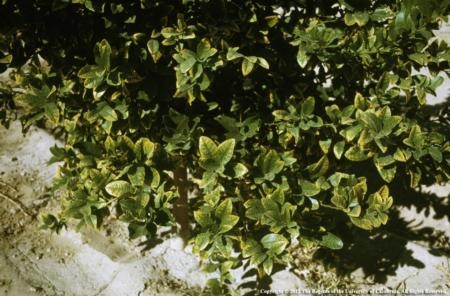- Author: Ben Faber
Irrigation efficiency requires not only uniform irrigation, but also the proper timing and amount of applied water. It is important that the irrigator know the system water application rate, either in inches per day, inches per hour, or gallons per hour.
Irrigation scheduling which determines the time and amount of water to be applied can be accomplished through a variety of methods, including measuring soil moisture, determining plant moisture status and determining evapotranspirational loss (ET crop or ETc). Evapotranspiration values are a measure of the actual amount of water well watered plants would use. This information is available in many areas of California from newspapers, irrigation districts, and over the Department of Water Resources CIMIS network California Irrigation Management Information System, or CIMIS Help Line (800) 922-4647).
Evapotranspiration varies seasonally and from year to year for a given location. DWR has developed a map of the average daily ET for various zones in California. These zones are distinctive because total sunlight, wind, relative humidity and temperature are the parameters that drive water loss and differ in each zone. Where the Central Valley becomes hot and cloudless in the summer, along the coast the intensity of the marine layer and its effect on sunshine differs from year to year.
Scheduling, as opposed to a fixed amount applied at a fixed time, is especially important in Southern California coastal valleys. Although the average annual irrigation requirement is about 2 feet of applied water per year (2 acre-feet per acre or 651,702 gallons per acre), this value varies tremendously from year to year, from as little as 18 inches to as much as 3 feet.
One of the most important variables in the quantity of applied water is the length of the rainfall season and the effectiveness of the rainfall. The rainfall season determines the length of the irrigation season and effective rainfall determines how much the plant can use. Effective rainfall is defined as the amount of rainfall, which is retained in the root zone of the tree. For example, consider a rooting depth of 2 feet and each foot holds 1 inch of available water. If you have just irrigated or if it rained 2 inches yesterday and it rains 2 inches today, none of today's rain is effective since the soil was already moist. It did leach salts out, however. Rain events of less than 0.25 inches are also not considered effective.
Determining an irrigation schedule based on tree water requirement falls into three broad categories of technology - plantbased, soil-based and weather-based. Many of these technologies are proven and have been in use for years. Others are more experimental and have not been fully tested. In several cases improved electronics and digitalization have put a new spin on older technologies. A method of determining when to irrigate should be learned by all growers and often a combination of techniques can be employed.
Plant-based Scheduling Methods
The plant is the ideal subject to measure, since it is integrating all the various factors driving water loss as well as soil moisture and any stresses such as soil salinity and plant health. To be a useful tool in irrigation scheduling, plant-based measuring devices must provide indicators of stress before that stress reaches levels that result in yield decreases. The methods include:
- Pressure chamber (pressure bomb or Schollander pressure chamber) measures plant water tension by applying a comparable air pressure to a leaf or stem. The amount of pressure required to equilibrate with the plant sap indicates how much stress the plant is under.
- Trunk diameter fluctuations (shrink/swell), measured continuously with linear variable displacement transducers (LVDTs), can be used to calculate parameters that are directly related to tree stress.
- Stem flow gauge estimates transpiration by placing a heat source on the trunk of the tree and then measuring the temperature differential along a trunk.
- Porometer measures the ability of a leaf to transpire, so when the leaf is under water stress then less water is transpired.
- Infrared thermometry measures the canopy temperature as affected by the rate of transpiration, so as the plant goes under water stress, the leaves gets warmer.
- Visual symptoms (wilting, leaf curling) are the cheapest method, but the most expensive in the long run.
- While these techniques can be valuable for scientific use, there has been little adoption in commercial agriculture. With the exception of the pressure chamber and LVDTs, this is due to the aforementioned problem of being able to identify mild water stress. Another reason for their lack of use by commercial agriculture, specifically subtropicals, is that there are logistical problems with mature trees, such as with the stem flow gauge and infrared thermometry. At this time, the pressure chamber is the state of the art in measuring tree water stress in subtropicals while recent research indicates that the LVDTs show promise for automating irrigation scheduling.
Soil-based Scheduling Methods
A rule of thumb is that irrigation timing should occur when about 50% of the water available to the plant has been depleted from the soil. The 50% figure is arbitrary; it allows a buffer of water in the soil in case the weather suddenly turns hot and windy.
Of course a sandy soil will hold less water than a clay soil, so irrigation will be more frequent. A common perception is that it takes more water to grow plants in sandy soil than clay soil. The total amount required for the whole year by the tree will not be changed by the soil type. This is because it is the sun, wind, temperature and humidity, which decides how much water the tree, will need. The soil is only the reservoir.
To check the water content in the soil, take a trowel, shovel, or soil tube and dig down 8 to 16 inches. A soil that has about 50% available water remaining will feel as follows:
Soil texture
- coarse - appears almost dry, will form a ball that does not hold shape;
- loamy - forms a ball, somewhat moldable, will form a weak ribbon when squeezed between fingers, dark color;
- clayey - forms a good ball, makes a ribbon an inch or so long, dark color, slightly sticky.
Irrigation timing can be determined and also mechanized with the use of a tensiometer. These water filled tubes with a pressure gauge accurately reflect the amount of energy a plant needs to extract water from the soil. The pressure gauge measures "tension values" in centibar units (cbars). When the gauge reads 30 cbars, it is a good time to irrigate.
Placement of the tensiometers requires that they be within the root zone, between the emitter and the tree trunk. Having two tensiometers next to each can be helpful in deciding both when to turn the system on and when to turn it off. A tensiometer at a one-foot depth tells when the water should be turned on and a tensiometer at three feet tells when to turn the system off. Placing a plastic milk crate over the device will prevent pickers from kicking them over.
There are other devices on the market for measuring soil moisture. Gypsum blocks are very effective. Although the part in the ground is inexpensive, the reading device costs in the $250 range. This cost means a large enough acreage is required to spread out the cost of the system.
There are portable meters on the market for measuring soil moisture. These meters rely on an electrical current carried by water in the soil. Even the cheap $10 ones can give a rough estimate of the soil water content. None are very effective in rocky ground, because their sensitive tips break easily.
The amount of water to apply at an irrigation depends on the amount of water held within the root zone. A loamy soil where a microsprinkler with a 20-foot diameter throw has wetted a twofoot depth will hold about 200 gallons of water at 50% of the soils water holding capacity. Exceeding this amount of water will help leach salts; but if far in excess, additional water is only pushing existing water out of the root zone.
It is best to follow one or two irrigation cycles to find out how long to run the system to achieve a certain depth of infiltration. This can be done with a shovel or more easily with a pointed rod or tensiometers. Water moves in a wetting front, and the wetted soil will allow the rod to be pushed in to the depth of dry soil. The system should be run to find out how long it takes water to infiltrate to a depth of two and three feet. That information will indicate how long to run the system when irrigating.
Applying water to achieve a two to three foot depth may take several hours. If run-off occurs, the system may be turned off for a few hours, then turned on again to get the total run time required to infiltrate to a given depth. If run-off is severe, use emitters with a smaller flow rate.
Soil-based methods monitor some aspect of soil moisture which, depending on the method, requires some correlation to plant water use. Some of the methods are well understood and inexpensive, others are expensive, inaccurate, inappropriate or not well researched. Some of the techniques allow multiple site readings while others require a device to be left in place. Some measure soil water directly, like oven-drying and others measure some other parameter with is associated with water content, such as electrical conductance. Some are affected by salts or soil iron content and others have limited value in the desired soil moisture range. Some, like tensiometers and gypsum blocks, give a reading from a porous material, which comes to equilibrium with soil moisture, while many others use the soil directly as the measured media. This is an important distinction since discontinuities in the soil caused by rocks or gopher holes can affect readings when the soil is used to carry a signal. Also, times have changed and some of the old techniques have been improved. For example, gravimetric oven-drying can now be done by microwave, considerably speeding up the process. Tensiometers and gypsum blocks can now be found with digital readouts and connections to data loggers, which make data easier to manage. There are quite a number of devices on the market and the following chart will shed some light on their differences.
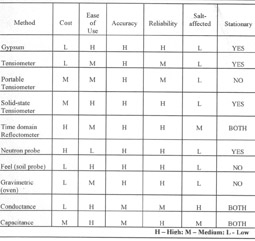
As with any tool, the value of these devices increases with use and familiarity. Even though several of these are listed as stationary devices, by placing them in representative positions in the orchard, they can accurately reflect the rest of the orchard. Several of the devices are listed in the table as being both stationary and portable; this is because there are various models that can act one way or the other. The "Ease of Use" category in the table indicates not just the ease of reading the device, but also the maintenance required for it.
Weather-based Methods of Irrigation Scheduling
Another scheduling technique that has become popular is the use of weather data that has been converted to a crop water use value. This value is the estimated amount of water an orchard would use. The value is often referred to as the evapotranspiration (ET) of the crop. ET is the amount of water that can be lost by a well-watered crop either through the leaves (transpiration) or evaporation from the surface of the soil. By applying the ET amount at an irrigation, the trees are kept at optimum moisture content. The technique is often called the water budget method or checkbook scheduling.
The CIMIS network of over 50 weather stations calculates reference evapotranspiration (ETo). This value is an estimate of the amount of water lost from a well-watered field of grass. Grass is the standard or reference for all other crops. ETo is modified for the specific crop with a crop coefficient (kc). The formula for converting ETo to crop ET is: ETo X kc = ETcrop.
For a full-grown subtropical orchard a kc of 0.65 is used in most of the State, but in the desert growing areas, 0.56 is used. With smaller trees, a smaller kc is used. When trees are young and intercept little energy to drive water loss, a kc of 0.05 works well. As the trees increase in size to where their shade covers about 65% the soil surface, the kc is gradually increased each year. With rapidly growing trees, the kc increase is usually about 10 % each year, until about year 8 when the 65% figure is reached. A correction factor needs to be incorporated for the irrigation system distribution uniformity, as well.
If the orchard is cover cropped for part or all of the year, the period during which the cover is present needs to be recognized in the water use calculation. A soil that is covered by a cover crop and trees uses water just like a mature orchard. Therefore, if the young orchard is covered by a perennial cover crop a kc of 0.65 is used regardless of tree size. If a winter annual cover is used, that uses only rainfall for its growth, correction is not usually necessary in a high rainfall year. But in low rainfall years, the water requirements of the cover need to be recognized in the irrigation program.
Reference evapotranspiration values are available from many irrigation districts, CIMIS, several weekly journals and magazines. In Ventura County, the values are available through County Flood Control, and in San Diego County, they are available from the Resource Conservation Districts.
One of the drawbacks of the centralized weather stations is that in hilly terrain with different sun exposures, the station values can be quite different from the water loss at a grove. When using evapotranspiration figures it is always important to back up the estimates with field checks in the grove. An alternative to using the centralized weather stations is establishing one of your own. These electronic stations cost in the range of $5,000 and require regular maintenance as well.
A simpler weather station can be developed with an evaporation pan or an atmometer (atmosphere meter). Both of these devices actually measure the loss of water due to evaporation and since the physics of evaporation and transpiration are very similar, the values can easily be used in a water budget.
The major drawback to the evaporation pan is the maintenance required to keep birds, coyotes, and bees from causing inaccurate readings. Algae also needs to be kept free of the pool. An atmometer is a closed system with a ceramic head, much like a tensiometer. As water is drawn out of a reservoir, a sight tube shows how much water has been evaporated. The atmometer is more expensive (~$300) than a pan, but it is much easier to maintain.
Regardless of what scheduling technique or combination of techniques is used, a thorough evaluation of the system needs to be performed so that a known amount of water is being applied. Until volume and distribution of water are known, it makes little sense to schedule applications.
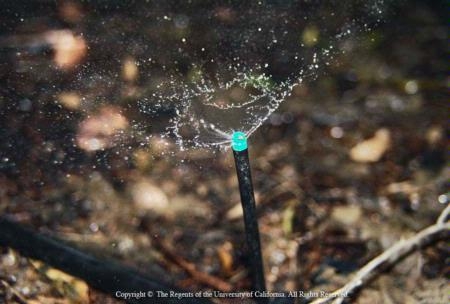
- Author: Blake Sanden
The best key to unlock efficient irrigation practice is to know exactly how much water your crop uses and replace it in a timely fashion that matches your irrigation system capacity and avoids crop stress and water logging. We have good “normal year” estimates of citrus water use (evapotranspiration, ET) for the San Joaquin Valley, but as any grower knows very few blocks are “normal”. The Frost Nucellar on the Cajon loamy sand and fanjets in Edison doesn't behave the same as Fukumoto navel planted to double-line drip on an Exeter clay loam.
So what's the trick for hitting optimum water management for a particular block? You have to keep account of your soil moisture reservoir in the crop root zone. Tracking soil moisture tells you whether you're putting on too much or too little water to meet crop needs. It's also the key to increasing fruit set and quality in many crops such as canning tomatoes, improving flavor in most wine grape varieties and possibly help control puff and crease in citrus.
But any farmer and most ag consultants will tell you that checking soil moisture is not for the faint of heart because it requires auguring holes, pushing a steel probe tube, and/or installing soil moisture monitoring instruments to depths of 2 to 6 feet depending on the crop. Checking instruments or hand probing needs to be done on at least a weekly basis to be useful.
After pushing, twisting, pounding and digging thousands of holes in hundreds of fields around the San Joaquin Valley I can testify to the fact that this is only slightly more fun than shoveling manure, and it's a whole lot harder on your shoulders and wrists. The result is that it's not done very often, if at all, and farmers tend to stick to a traditional irrigation schedule. Given all the other decisions and details growers have to see to on a daily basis it's not surprising this activity gets pushed to the side. At the same time, the years of experience a farmer has with a crop and with a particular field often give him an intuitive sense of how to run the water and end up being 75 to 90% efficient anyway! So if you're already this efficient then why auger holes and check moisture anyway?
There are two reasons: 1) You're not really sure that you're at the optimum point of the crop water use curve until you check, and 2) The simple math of cost versus benefit. Water monitoring consulting services run around $15/acre/season depending on total acreage and what degree of technology and reporting you want done. If this is the only cost you incur to get the extra 5% out of a 3-bale cotton crop then you've made an extra $22/acre even if cotton is only 50 cents/lb. Even at just $2 net/box, the total from an extra 15 boxes of grapes or extra fancy oranges is a 100% return on your $15 investment.
Many growers have tried tensiometers in the past and usually get fed up with the maintenance. A new generation of medium and high technology sensors is now available to growers and consultants. The huge diversity of sensors can be intimidating at first glance but these systems can make this job easier, more accurate and even more affordable. The biggest advantage to the new technology is the use of a continuously recording data logger coupled to responsive soil moisture sensors.
A series of irrigation management/monitoring demonstrations by UC Cooperative Extension over the last 3 years in Kern County has looked at using a combination of 6 granular matrix electrical resistance blocks (Watermark®) coupled to a logger with a graphic display (Hansen AM400®) to allow growers a “push button” look at 5 weeks of soil moisture history at any time during the season. The cost of this system is about $600 and should be good for 3 to 5 years. This gives growers a look at the dynamic changes in soil moisture due to actual crop water use and subsequent recharge of the profile during irrigation. The pattern of the peaks and rate of change of these readings is more useful than the actual numbers themselves. Many different sensors and loggers provide this type of information but the AM400/Watermark system is the only combination providing a graphic display in the field without having to download to a computer. Computer downloads can also be done anytime during the season to develop charts such as those shown below.
Charts (a), (b) and (c) show the changes in soil moisture for 2 different blocks of early navels in the Edison area of Kern County for summer 2003. Comments are placed in boxes connected to explain what these patterns mean.
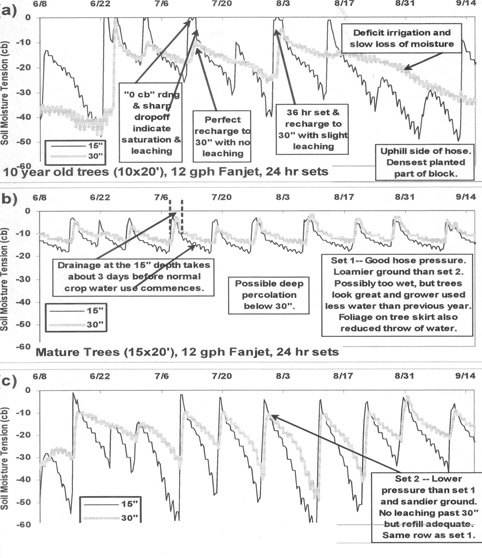
Even though all three of these monitoring locations are within 800 feet of each other we see very different changes in soil moisture. The hedgerow block (a) has many skips as the grower has begun pulling trees and he wants to avoid over watering the whole block.NEW PARA Charts (b) and (c) are for trees in the same row but different sets. Slightly higher hose pressures and loamier ground keep (b) moister than (c), which shows almost a perfectly efficient pattern of crop water use and recharge. To keep the trees in (c) from looking “hot” required an irrigation frequency for this block that resulted in the wetter condition at location (b). But the bottom line for the grower is these trees have never looked better, he used less water in 2003 and had a better packout than in 2002.
Checkout my website,for some calibration curves and other field examples, both good and bad, under “Using Watermarks in Different Soils”. Irrometer, Onset and Spectrum companies also make inexpensive loggers (can be found here. (Note: use of any product names is not intended as a commercial endorsement.)
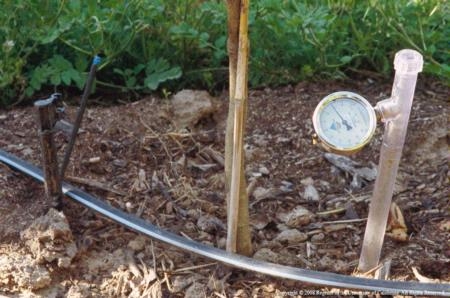
- Posted By: Chris M. Webb
- Written by: Neil O’Connell, Farm Advisor
Deficit irrigation research by Dr.David Goldhamer has yielded some interesting results in navel oranges. In the original trial on mature, vigorous Frost Nucellar navels on a sandy loam soil, applied water was reduced by varying amounts and at different times during the irrigation season depending upon the treatment imposed. Regulated deficit irrigation is applying a fixed % less than the full water requirement of the tree during a specific period in the irrigation season.
The fully irrigated control trees received a volume of water estimated to be the tree water requirements based upon size and current weather conditions –using the current water requirements of a pasture grass (Eto cimis station) multiplied by a crop factor for mature citrus which is 0.65. The objective of the trial was to determine if the volume of applied water could be reduced by varying amounts and at different times during the irrigation season compared to a fully irrigated control without a loss in yield or quality and perhaps improved peel appearance. Measurements were made of fruit growth during the season and of yield and fruit quality at harvest; the amount of water applied with each treatment was measured as well. Research conducted over the years has indicated that citrus was sensitive to reduced irrigation particularly at petal fall and during early fruit development with loss in yield or fruit size.
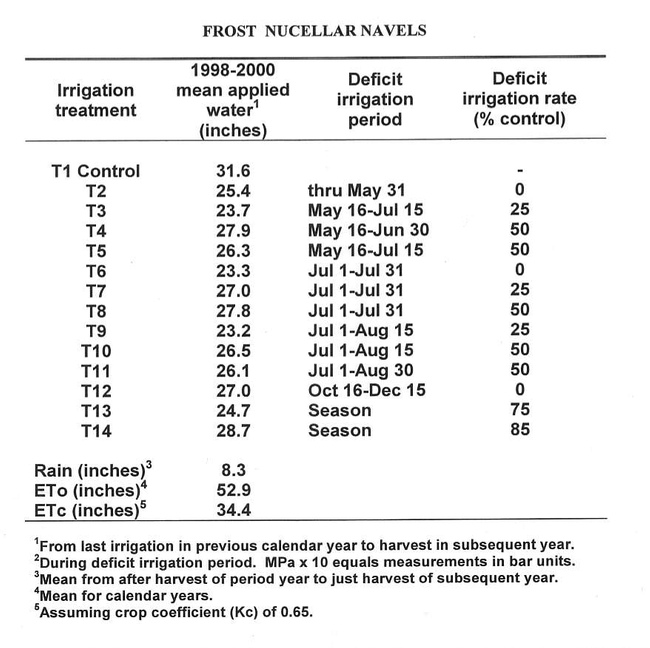
The current study indicated that where deficit irrigation was applied, a slowing in growth rate of the fruit was observed compared to the fully irrigated tree, but when full irrigation was resumed at the end of the treatment period, accelerated growth occurred compared to the control trees. Yield at harvest was not significantly different among any of the reduced irrigation treatments compared to the fully irrigated control trees. There was also no difference in number of fruit per tree or packable cartons among the treatments compared to the control. An additional result was that there was significantly less creasing of the peel in two of the treatments--T2 and T3-- compared to the fully irrigated trees. Both of these treatments imposed stress early in the season and reduced applied water by 6.2 and 7.9 inches, respectively. This equates to 19.6 and 22.8% less applied water than the fully irrigated control. This research demonstrated that less than the full water requirements of the tree can be applied at specific times during the fruit development period under controlled and known conditions without a loss in yield.
Ongoing research on Lane Late navels is being conducted with the object of reducing granulation by regulating fruit size for an optimum fruit size at harvest. Fruit held late for harvest frequently results in a significant portion of the fruit being large. Historically large fruit have a higher percentage of the fruit with granulation. This fruit may be less than optimum size (too large) for current market conditions as well. Based upon the previous regulated deficit irrigation study the object of the current trial is to regulate size based upon imposed stress by applying less than full irrigation during specific periods in the irrigation season that is early, mid and late season stress.
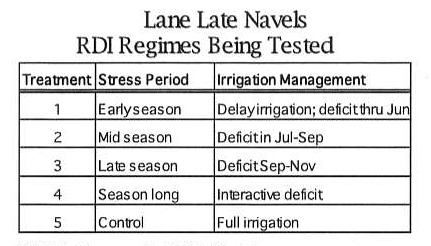
Less water is applied than required by a fully irrigated tree for the period, and growth of the fruit is monitored compared to the fully irrigated tree. Adjustments are made in applied water based upon the growth of the fruit in the stress tree as well as measured tree water status (pressure chamber) compared to the fully irrigated control. The same type of response to the deficit irrigation that occurred with the Frost Nucellar has been observed. A slowing of growth under the deficit irrigation, then accelerated growth with resumption of full irrigation. However, this study imposes stress over longer periods that the previous study and thus, the desired reductions in fruit size at harvest have occurred in all but the T1 treatments. The first year of the study, when fruit loads were relatively high, showed that early season stress reduced granulation (6.5% for all sizes vs. 17% for the control) with no effect on size. Continuous stress reduced both granulation (mean of 3.8 for all sizes vs. 17% for the control) and fruit size. In the second study year with lower fruit loads, there was no reduction in fruit load but fruit size was reduced to a greater extent in the mid, late summer, and continuous stress treatments. This reduced the percentage of unwanted very large size (24 and 32 count) fruit such that revenue to the grower was higher by from $1300 to $3000 per acre, depending on whether 24s and 32s were considered marketable.
Deficit irrigation imposes a level of stress on the tree related to the amount of water that the tree is shorted compared to a fully irrigated tree. The tolerance of the tree to this stress is related to the vigor of the tree, the period in the fruit development cycle, weather conditions, and how long the stress continues, and the magnitude of the stress. Under the conditions of these studies the level of stress imposed is carefully monitored and the deficit irrigation treatments are under known conditions and are carefully controlled. Where conditions are not known by the grower the trees may already be under some stress, the vigor of the trees may not be high; the irrigation system may not be uniform and therefore not delivering the expected volume. Attempting deficit irrigation under these circumstances runs the risk of reducing yield perhaps seriously as well as fruit size.
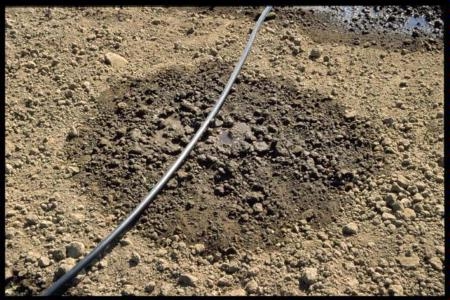
- Posted By: Chris M. Webb
- Written by: Mary Bianchi
We’d like to challenge you to take the following quiz. Take a minute to place a check mark next to all the practices you regularly employ in your operation. Go ahead – we won’t be collecting them!
Part 1
Yes/ No I know what the nitrogen requirements (lbs actual N/acre/year or /tree/year) are for my crops
Yes/ No I know what the nitrogen levels are in soil amendments I use in my operation (compost, manure, crop residues, etc.)
Yes/ No I have lab analysis of my well/irrigation water.
Yes/ No I monitor tissue levels of nitrogen in my crops to help with fertilizer decisions.
Yes/ No I have put together a nutrient budget that considers all sources of nitrogen for the crops I produce.
Part 2
Yes/ No When I do apply nitrogen, applications are timed according to crop requirements.
Yes/ No I use fertigation to apply nitrogen.
Yes/ No Applications of nitrogen are split into smaller doses to improve efficiency of uptake.
Yes/ No I use cover crops that help manage nitrogen availability.
Yes/ No I manage irrigations to avoid nutrient loss below the rootzone of the crop.
If you marked yes to these as regular activities, you’ve just taken steps in showing how your production decisions can protect water quality. The combined activities noted in Part 1 constitute a Management Practice that protects water quality by developing a nutrient budget to help apply only the appropriate amounts of fertilizer. Activities in Part 2 may alone or in combination constitute Management Practices that help ensure fertilizers are applied efficiently.
Every grower uses ‘management practices’, many of which are meant to generate the best possible product for market. Depending on who you’re talking with, the term ‘management practice’ can be something your Farm Advisor recommends (i.e., pruning to control tree height), your produce buyer suggests (protect avocados in bins from sun scald), or the term can have regulatory connotations.
You’ve all probably heard the term Best Management Practices. Best Management Practice (BMP) is defined in the Federal Clean Water Act of 1987, as “a practice or combination of practices that is determined by a state to be the most effective means of preventing or reducing the amount of pollution generated by nonpoint sources to a level compatible with water quality goals.” The term “best” is subject to interpretation and point of view. In recognition of this, the Coastal Zone Reauthorization Amendment (2000) substituted the terms Management Measures and Management Practices.
How can you tell if any individual activity constitutes a Management Practice that meets the needs of a regulatory program to protect water quality? Ask yourself this question: Can the activity stand alone and result in water quality benefits? Just knowing the nitrogen requirements of your crop doesn’t result in any water quality benefits – developing and using a nitrogen budget for your crop can. A nitrogen budget that takes into account the nutrients applied in amendments, irrigation water, and fertilizers in meeting the requirements of your crop does have the potential to protect water quality from nitrogen pollution from your operation.
Some Management Practices can have water quality benefits as a stand alone activity. Cover crops are recognized as a Management Practice that can help manage both sediment and nutrients to reduce the potential of pollution when used appropriately.
Water quality protection is being asked of all industries in California. You have the opportunity to take credit for all of the activities you already do, like the ones listed above, that protect your local water bodies and/or groundwater from nonpoint source pollution from your operation. Look for additional articles in the coming issues to help you in this effort.
For additional background information on water quality legislation, and nonpoint source pollution from agriculture you can download the following free publications from the University of California’s Farm Water Quality Program:
Water Pollution Control Legislation
Nonpoint Sources of Pollution from Irrigated Agriculture
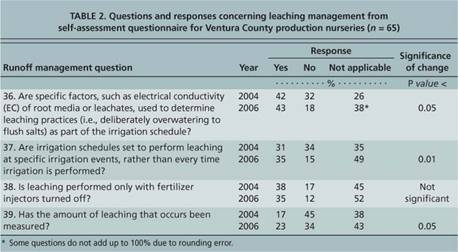
- Written by: Jim Downer
Horticulture is the cultivation of plants as ornamentals or for the production of food. When things go wrong (plants grow poorly or not at all), horticulturists sometimes turn to products that can “cure”, revitalize, invigorate, stimulate or enhance the growth of their plant or crop. A horticultural consultant colleague of mine, has often told me, “There are no miracles!” Unfortunately, when nothing else has worked, many people will turn to so called miracle products in hopes of a cure. Products that purport to give you that miracle are termed snake oil. Snake oil products claim many things, but usually without referenced research reports from Universities. Snake oil products almost always offer numerous testimonials to support their use. Those who provide testimonials are usually not researchers. Professional horticulturists, farmers and gardeners should be able to recognize snake oil products and avoid their use—we should base our horticultural decisions on sound research based information, not on marketing claims and testimonial based admonitions.
Science Based
The most creative and effectively marketed snake oil products often cite sound biological facts or knowledge and then attempt to link their product to this knowledge, but references to the published research about their product are always missing. Very often, snake oil products will use jargon relating to the chemistry, biology or microbiology of their products in an attempt to impress potential users with terms that sound informative but are used in a meaningless context. In some cases, these products are “ambulance chasers” and follow the most recent pest outbreak or natural disaster in an attempt to make money from desperate clients.
Works on a new principle
A prime indicator of snake oil products are that they rely on a new principle that gives them their efficacy. This “new” principle may be entirely fabricated by the manufacturer or have a shred of truth based in current science, but the science is so distorted that there is no truth in the claim. Very often the active ingredient is not listed on the label and is a “secret” or proprietary substance. A clear explanation of the scientific principle, its discoverer, where it was published and how it relates to the product at hand is rarely or never available.
Research Based
Some products make claims of efficacy based on extensive research. But who did the research? Upon inspection, we find that independent, third party research, published in a peer reviewed journal is lacking. In house research or research conducted by contract with other companies may not have the same degree of objectivity as University based research projects. Some products allude to University research but never tell the user that the research found that their product was not effective. Sometimes product literature tells outright lies about the efficacy of the product discussed in the research.
Sometimes a retired researcher will start selling a product based on the good research they have done in the past, but with little bearing on the efficacy of the current product or material. Past affiliations with Universities are no guarantee that products developed after the researcher has left the institution are efficacious. Only current, published reports of efficacy in peer reviewed journals are acceptable references.
Snake oil products can sometimes be lawbreakers!
Products that purport to control a pest such as a disease organism or an insect or weed, but are not registered with the State or Federal EPA and do not have pesticide registration numbers, are not pesticides and can not be used for that purpose. It is a violation of state and federal laws to apply products as pesticides when they are not labeled for that use. Sometimes a product claims to boost plant health and thus avoid diseases, also avoiding the pesticide registration process. Health boosters, activators, and stimulators are not considered pesticides by regulatory agencies; however, they are often not efficacious or supported by University research findings.
It is too good to be true
Some problems like Armillaria (which causes root rot and basal cankers of many ornamental and orchard trees) are essentially incurable. All the traditional sources of information suggest ways to limit the disease but no “cure” is offered. Along comes a product that kills the pathogen and reinvigorates the sick host. Sounds too good to be true? Then the product is probably snake oil. Rarely do efficacious pest management practices or products come to market without some kind of University based research. Again, there are no miracles.
Soil Microbiology Products and Services
All plants have root systems and almost all are rooting in soil, and since we do not see their roots very well, there is a lot of snake oil that concerns soils and soil treatments. Polymers, growth activators, hormones, vitamins, fertilizers, worm castings, composts and their teas, are but a few products that may fall into this category. Since none of these products claim to be a pesticide, the careful efficacy testing required for state or federal registrations is not required. Efficacy claims can run to the extreme.
Mycorrhizal Fungi
Some of the most convincing products are those that have solid scientific basis for efficacy but no direct evidence that they work. A classical example is fungal mycorrhizae forming inoculants for landscape trees. Mycorrhizae are not snake oil. However, some products that purport all the things that mycorrhizae can and do achieve for plants may be. Many of the numerous scientific papers written on mycorrhizal fungi do not indicate that mycorrhizae are necessarily lacking from most soils, or that the products used to add them to soil are viable. In a study of ten commercial mycorrhizae products, Corkidi et al.(2004), found that four of the ten failed to infect the bioassay plants and in a second trial, three of the ten products failed to infect.
Biological control
A considerable amount of time is spent each year by companies producing biological control microorganisms. Although these often show good efficacy in university based laboratory or greenhouse trials, and this research is published, there are few products that show efficacy in field-based trials. Many of the Trichoderma based products simply do not work when applied as products outside the lab or greenhouse. Biological control of soilborne diseases is an elusive thing that we seek to understand constantly, catch glimpses of in the field, study intensively and consistently fail to recreate when and where we want it to happen. Rarely has a single organism been applied with disease control effect in field settings. Soil ecosystem level changes (like massive mulch applications) can promote biological control of root rot diseases, but these effects are caused by many kinds of fungi that are naturally occurring in the environment.
Soil Food Webs
Manipulation of Soil Food Webs is purported to balance all the complexities of soil so that plants will grow well. The concept is to balance the various microorganisms so that the soil will benefit the crop at hand. Lab services are used to diagnose the organism content of a given soil sample. Horticulturists then use this information to make the recommended changes to modify the soil ecology and enhance plant performance. A “healthy soil” will grow healthy plants; a “sick soil” is unproductive. The theory predicts that in poorly managed soils, all the “good” fungi are killed and only the plant pathogens remain. The data relating good fungi to bad and how their populations interact is rarely given and published references with this information are lacking. Detailed information on the interactions of soil food webs with specific plant pathogenic fungi are distinctly lacking in the literature.
Soil food webs are complex. Ferris and others have found that nematodes are good indicators of the status of the soil food web. Since nematodes feed on fungi and bacteria, the two most important manipulators of organic carbon, nematode guilds can be monitored to determine the various successional stages of decomposers in a food web. Maintenance of labile sources of soil organic carbon ensures adequate levels of enrichment for opportunist bacterivore nematodes and thus adequate fertility necessary for crop growth. Labile organic carbon can be supplied by organic amendments or by the roots left behind after a crop is harvested. Organisms come and go in the soil, dependent on carbon available for their growth. If one group (guild) of bacteria or fungi use up the available food, another will take over on what is left. Ferris and others refer to the changes in food web function as functional succession. Analysis of nematode fauna has emerged as a bioindicator of soil condition and of functional and structural makeup of the soil food web. Nematodes are used to assess the food web because evaluation of the food web structure is in itself very difficult; you would have to inventory and assess all of the participants. Functional analysis of the web is difficult because it may not indicate how the various functions are being accomplished or whether they are sustainable. Merely counting bacteria and fungi gives nothing but a snapshot view of what was happening the day the samples were obtained. Since nematodes are the most abundant animal in soils, they can be used as a tool in assessing the structure, function and resilience of the soil food web.This understanding of the biology of soils is new and not yet practicably applicable on a wide basis.
Compost Teas
A natural extension of food web science is the use of compost teas to “strengthen” the food web. Compost teas are “brewed” from compost usually in an aerobic fermenter. They may be aerated or non-aearated. Because the feedstock (compost) is highly variable, the resultant teas can also be quite different. Due to the tremendous number of variables in “brewing” compost teas (ph, fermentation time, water source and content, temperature, added nutrients, feedstocks and aerated vs. not) the results are hard to replicate and quite variable; this makes studies hard to publish. Compost teas contain many different substances plus nutrients that plants can use for growth or that can act as plant growth stimulators. The problem comes with rates. How much do you apply and how often? There is a lot of experimentation going on by the users of the teas but not much validation in the academic community (especially research on trees) due to the variability of these systems.
Horticultural Myths
These are practices and or products that many people working in our industry may hold to be useful but have no scientific basis for their method of action. They are formed from misinformation passed on over the generations or from common observations that are misinterpreted. A good example is that of placing gravel or rocks in the bottom of a planting hole to increase drainage for the rootball. This is borne out by the fact that these drawings exist in old books. Even though the mistakes are corrected in modern texts the myth that rocks in the bottom of a planting hole creates drainage, lives on today, and actually shows up in some modern landscape architectural specifications.
Another myth is the notion that pruning woody plants stimulates their growth. The more severe the pruning, the more the plant is shocked into good growth. Although the growth of latent buds from major limbs that have been headed back leads to copious regrowth, if you compare the overall growth of this tree to a similar unpruned tree, the pruned tree will have grown less on the main trunk over the same amount of time. Transplanted trees do not need to be pruned to compensate for their root loss. Sometimes when trees are moved, compensatory pruning is done to “balance” the roots with the shoots. Research has consistently shown that as mentioned above, pruning is a growth retarding process, and thus slows the establishment of transplanted trees.
There are many funny ideas about mulches. Almost any mulch can be applied to the soil surface with few bad affects. There are some exceptions where the mulch contains toxic acids or contains weed seeds. However, the belief that high C:N ratio mulches (contain a lot of wood) will extract nitrogen from under the soils to which they are applied has little or no scientific evidence to support it. Just the opposite is true. Over time, woody mulches decay and release nitrogen to underlying root systems.
A product that has attained Horticultural Urban Legend status is Vitamin B1. In the 1930's, Caltech's James Bonner discovered, that Thiamin (vitamin B1) was able to restore growth to pea root tips that had languished in tissue culture. It was concluded to be essential in plant growth media. Bonner later found that B1 had little growth promoting effects on most whole plants in hydroponic culture, but that some plants such as camellia, and cosmos showed dramatic growth increased to added B1 vitamins. Bonner latter discovered that thiamin production was associated with the foliage of growing plants. The hoax was on in 1939 when Better Homes and Gardens magazine ran an article that claimed thiamin would produce five inch rose buds, daffodils bigger than a salad plate and snapdragons six feet tall! In1940, Bonner entered into collaborative research with Merck pharmaceutical company to master the growth promoting effects of B1, account for the wide variability in his experimental results and develop a product that gave consistent good results. Bonner proved during this period that B1 was phloem mobile was made in leaves and transported downward in stems. Bonner's experiments with Cosmos continued, but with varying results, so he sought cooperative research with University experiment stations around the country. Results were mixed, some showed growth promotion, most not. By 1940,other physiologists widely reported negative results. By1942 Bonner was debunking his own discoveries, stating that the effect only ever occurred in very few plants and that since thiamin was found in soil itself, field applications were unlikely to benefit plants. Bonner ultimately fully retracted his claims of efficacy by saying “It is now certain, however, that additions of vitamin B1 to intact growing plants have no significant or useful place in horticultural or agricultural practice”. The public craze and fanatical headlines about thiamin continued but Merck withdrew all interest and funding in the concept so as to distance itself from a product that does not work.
Conclusions
New products come and go. Snake oil products often disappear rapidly, when their efficacy fails to materialize after application. Products that confound their purported results with fertilizers or growth stimulators can persist, but eventually they too fail to live up to expectations at some point and will fade from popularity. Try to obtain some kind of consensus with university based research or other peer reviewed research reports, field efficacy trials that you run for yourself, and not on the testimonials of others. If you decide to conduct your own trials, they must be replicated and statistically analyzable, otherwise they are little more than anecdotal observations that have little value in quantifying the effects of the above mentioned products and practices. For more help with trials, seek out University Extension agents and specialists. This is their job, and they are willing partners in field research. After awhile, you will be able to ascertain the nature of the “oil” before you purchase it.
